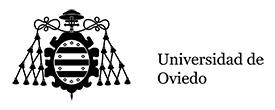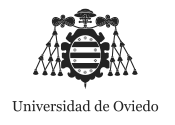Estudia
- Artes y humanidades
- Ciencias
- Ciencias de la salud
- Ciencias sociales y jurídicas
-
Ingeniería y arquitectura
- Doble Máster Universitario en Ingeniería Industrial e Ingeniería Energética
- Máster Erasmus Mundus en Ingeniería Mecatrónica
- Máster Universitario Erasmus Mundus en Tecnología y Gestión para la Economía Circular
- Máster Erasmus Mundus en Transporte Sostenible y Sistemas Eléctricos de Potencia
- Máster Universitario en Ciencia y Tecnología de Materiales
- Máster Universitario en Conversión de Energía Eléctrica y Sistemas de Potencia
- Máster Universitario en Conversión de Energía Eléctrica y Sistemas de Potencia (Plan antiguo)
- Máster Universitario en Dirección de Proyectos
- Máster Universitario en Geotecnología y Desarrollo de Proyectos SIG
- Máster Universitario en Ingeniería de Automatización e Informática Industrial
- Máster Universitario en Ingeniería de Caminos, Canales y Puertos
- Máster Universitario en Ingeniería de Minas
- Máster Universitario en Ingeniería de Telecomunicación
- Máster Universitario en Ingeniería Energética
- Máster Universitario en Ingeniería Industrial
- Máster Universitario en Ingeniería Informática
- Máster Universitario en Ingeniería Mecatrónica
- Máster Universitario en Ingeniería Química
- Máster Universitario en Ingeniería Web (nuevo-implantación en curso 2024-25)
- Máster Universitario en Ingeniería Web (En Extinción)
- Máster Universitario en Integridad y Durabilidad de Materiales, Componentes y Estructuras
- Máster Universitario en Náutica y Gestión del Transporte Marítimo
- Máster Universitario en Tecnologías Marinas y Mantenimiento
- Máster Universitario en Prevención de Riesgos Laborales
- Información, acceso y becas
Caracterización de Sólidos y Superficies en Ingeniería Química
- Clases Expositivas (20 Hours)
- Prácticas de Laboratorio (12 Hours)
- Tutorías Grupales (2 Hours)
- JOSE RAMON PAREDES ALVAREZ - Email
- JOSE RAMON PAREDES ALVAREZ - Email
The course “Characterization of solids and surfaces” belongs to the Process and Product Engineering module of the Master in Chemical Engineering. The course is elective, and it is taught during the second semester of the first year. It is taught by members of the Department of Chemical and Environmental Engineering and by instructors external to Universidad de Oviedo.
The main objective of this course is instructing the student on the fundamentals and applications of the most important instrumental techniques for characterization of solids and surfaces of interest in Chemical and Environmental Engineering, such as metals, polymers, catalysts, membranes, adsorbents, etc.
Although there are no compulsory requirements, apart from those obligatory to comply with the Master, students are recommended to have knowledge on Physical Chemistry, Thermodynamics, and Transport Phenomena.
This course aims to develop the following skills:
General skills: | |
CG1 | Be able to apply the scientific method and the principles of engineering and economy to formulate and solve complex problems of processes, operations, systems and services where matter changes in composition, state, or energy content, characteristic of the chemical industry and other related sectors, such as pharmaceutical, biotechnological, material, energy, food, or environmental. |
CG4 | Be able to do the appropriate research, undertake the design and manage the development of engineering solutions, in new or partially known environments, relating creativity, originality, innovation and technology transfer. |
CG6 | Be able to analyse the continuous development of product and processes, taking into consideration technical, health, safety and environmental aspects, as well as economic and quality reliance concerns. |
The specific skills are:
Specific skills | |
CIPP1 | Have a knowledge and understanding of Mathematics, Physics, Chemistry, Biology and other Sciences necessary to support application of key engineering principles. |
CIPP2 | Be able to design and optimize products, processes, systems and services for the chemical industry on the basis of the different chemical engineering areas, comprising of processes and transport phenomena, separation operations, and chemical, nuclear, electrochemical and biochemical reaction engineering. |
Upon completion of this course, students are expected to achieve the following learning outcomes:
Learning outcomes | |
RACSS1 | Understanding the fundamentals of the main techniques used for characterization of solids and surfaces: microscopies (optic, SEM, TEM), methods for morphological and crystallographic characterization, calorimetric methods, spectroscopic methods, methods based in resonance, etc. |
RACSS2 | Application of these techniques in the field of characterization of solids of interest in Chemical and Environmental Engineering, such as metals, polymers, catalysts, membranes, adsorbents, etc. |
RACSS3 | Selection of the adequate techniques as a function of the information required, as well as of technical and economic considerations. |
RACSS4 | Evaluation of the information obtained, in relation to the properties and applications of the materials studied. |
In this course, the fundamentals of the different techniques available for the characterization of solids and surfaces of interest in Chemical and Environmental Engineering (metals, polymers, catalysts, membranes, adsorbents, etc.) for the will be studied, together with the information that they can provide in this field. There will be specific lectures devoted to the different types of techniques:
1. Introduction. Technological importance of solid materials and surfaces. Introduction to Surface Chemistry.
2. Microscopies for characterization of solids: optical microscopies, transmission electron microscopy, scanning electron microscopy. Scanning tunneling microscopy.
3. Morphological characterization of solids. Methods based on physisorption. Porosimetries.
4. Chrystalographic characterization of solids. X ray diffraction: phase identification, evaluation of phase dispersion. Other techniques: EXAFS, XANRS and electron diffraction.
5. Vibrational spectroscopies. Infrared spectroscopy (DRIFT, FTIR, ATR). Raman spectroscopy.
6. Photoelectron spectroscopies: XPS, Auger, UPS.
7. Other spectroscopies: ionic, DRS. Mossbauer. Resonance spectroscopies (MAS-RMN and RSE).
8. Calorimetric methods: calorimetry, DSG, TG.
9. Characterization of the reactivity of solids and surfaces. Temperature programmed reaction/desorption.
10. Other characterization methods: electric, magnetic, chromatographic, mass spectrometry. New developments in solids characterization.
In order to rationalize the teaching organization, the content has been distributed according to the following educational modalities:
MODALITY | Hours | % | Total | |
Lectures and practical classes | Lectures | 17 | 15.1 | 34 (30%) |
Laboratory/field practice | 12 | 10.7 | ||
Group tutorials | 2 | 1.8 | ||
Written exam | 3 | 2.7 | ||
Independent study hours | Group work | 30 | 26.7 | 78.5 (70%) |
Individual work | 48.5 | 43.1 | ||
Total | 112.5 | |||
All materials will be available via the Virtual Campus, including the lectures presentations and the problems and practical examples to be solved.
Lectures on theoretical or practical subjects will be given by the instructors, helped by the corresponding graphic materials.
Laboratory and field practice sessions will take place in the labs of the Departamento de Ingeniería Química y Tecnología del Medio Ambiente, Universidad de Oviedo, other labs in Universidad de Oviedo, or external. Their aim is the knowledge by the students of the apparatuses and methods of the characterization techniques studied.
In Group Tutorials the students will present orally short works, prepared in small groups, which will be discussed.
The distribution of the study hours is indicated in the following table:
FACE TO FACE WORK | INDEPENDENT STUDY | |||||||||||
Subjects | Total hours | Lectures | Seminars | Lab/filed practice | Clinic/hospital practice | Group Tutorials | External practice | Assesment | Total | Group work | Individual work | Total |
1. Introduction. | 3.5 | 1 | 1 | 1 | 1.5 | 2.5 | ||||||
2. Microscopies. | 13 | 2 | 2 | 4 | 3.5 | 5.5 | 9 | |||||
3. Morphological characterization. | 13 | 2 | 2 | 4 | 3.5 | 5.5 | 9 | |||||
4. Chrystalographic characterization. | 13 | 2 | 2 | 4 | 3.5 | 5.5 | 9 | |||||
5. Vibrational spectrocopies. | 12 | 2 | 1 | 3 | 3.5 | 5.5 | 9 | |||||
6. Photoelectron microscopies. | 12 | 2 | 1 | 3 | 3.5 | 5.5 | 9 | |||||
7. Other spectroscopies. | 10 | 1 | 1 | 3.5 | 5.5 | 9 | ||||||
8. Calorimetries. | 13 | 2 | 2 | 4 | 3.5 | 5.5 | 9 | |||||
9. Characterization of reactivity. | 13 | 2 | 2 | 4 | 3.5 | 5.5 | 9 | |||||
10. Other chatacterization methods. | 5 | 1 | 1 | 1 | 3 | 4 | ||||||
Total | 112.5 | 17 | 12 | 2 | 3 | 34 | 30 | 48.5 | 78.5 | |||
The evaluation of the students will be carried by evaluation of the work and reports of the lab/field practice, a written exam, and the team work presented orally.
Attendance to the lab/field work sessions is compulsory; in duly justified cases, an attendance higher than 80% will be accepted. Active participation in all of them will also be taken into account.
In order to pass the course, the qualification obtained in lab/field practice and in the team work cannot be less than 50% of its maximum value. Likewise, the final written exam cannot be less than 40% of its maximum value. If these minimum qualifications are not met, the course is not passed.
To obtain a minimum of 5 points out of 10 in the evaluation of lab/field practice, it is essential to have obtained a minimum of 4 points in each and every one of the individual reports of each practice. This implies having performed all the required simulations and tasks.
Final written exam. At the end of the course, there will be a written exam, consisting of 5 theoretical or theoretical/practical questions (50% of the exam grade), and 2 problems (50% of the exam grade). In order to pass the course, the grade in the theoretical part should be at least 30% of the assigned 5 points, and the grade in the problems part should be at least 30% of the assigned 5 points. The grade of the written exam corresponds to 70 % of the course final grade.
The value of each of the evaluation systems, both in the ordinary and extraordinary calls, expressed as a percentage, will be as follows:
Assignment | Learning outcomes | % |
Evaluation of lab/field practice | All | 15 % |
Evaluation of group work | All | 15 % |
Written exam | All | 70 % |
If these conditions are met, the final mark is calculated using the abovementioned percentages.
The qualification of the Lab/field practice and Group work will be maintained in all the course calls of the corresponding academic year.
In the following calls within the same academic year, the students will present themselves to the aspects not surpassed in the first call of the course, and the evaluation will be made according to the criteria of the first call.
Resources:
Audiovisual media will be used which, as indicated previously, will be available to students in advance. The use of specialized bibliography available through the library network of the Universidad de Oviedo (BUO), located especially in the Faculty of Chemistry, as well as networked resources (electronic publications and databases) will be promoted.
The Department of Chemical and Environmental Engineering has different characterization techniques that will be used in the course: optical microscopy, nitrogen adsorption porosimetry, scanning differential calorimetry, temperature programmed techniques (TPR, TPO). The Scientific-Technical Services of Universidad de Oviedo have the following techniques: TEM, SEM, EDX, thermogravimetry, XRD, XPS, IR-FT. It is possible to visit other institutions where other techniques (mercury porosimetry, scanning tunnelling microscopy) are available.
Bibliography:
1. Characterization of Solid Materials and Heterogeneous Catalysts: From Structure to Surface Reactivity, Volume 1&2. Editors: Michel Che, Jacques C. Védrine, Wiley-VCH Verlag GmbH & Co. KGaA, 2012.
2. Spectroscopy in Catalysis, J. W. Niemantsverdriet, John Wiley & Sons, 2008.
3. Electron Microscopy: Principles and Fundamentals, Editores: S. Amelinckx, Dirk van Dyck, J. van Landuyt, Gustaaf van Tendeloo., VCH, 2008.
4. Calorimetry: Fundamentals, Instrumentation and Applications, Stefan Mathias Sarge, Günther W. H. Höhne, Wolfgang Hemminger, Wiley, 2014.

